Knee pain is one of the most common reasons that people give as to why they stop playing sports, running or jogging, or even just active hobbies like gardening. We know there is nothing worse than having to give up doing something you love because of the pain it might be causing. It is possible to relieve and prevent most knee pain using simple exercises. Protect your knees… you only get two!
We want you to be healthy, active, and pain-free for as long as possible so here are our 7 best exercises to help prevent knee pain. These can be done as a stand-alone workout or as part of a great lower body warm-up before a longer workout, run, or sports game. We find it works best to do them in order working from the ankles and feet up to quads and hamstrings.
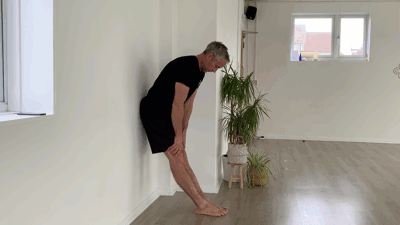
1. Tibialis Raises
This exercise is going to strengthen the muscle that runs up the front of your shin between the knee and the ankle called the tibialis anterior. It is responsible for deceleration, so when it’s strong and working well it significantly reduces the amount of force going through your knee joints, helping to protect them.
Lean with your back against a wall and your feet about 1 to 2 feet away from the wall, so your legs are at an angle. Straighten your legs and contract your quads on the front of your thighs, your kneecaps should lift up as a result. Then lift both feet up away from the floor, pivoting on your heels, then lower them back down. Repeat this action for 25 repetitions. Sounds easy right, but you wait until you get to rep 15 and above! As you get stronger at this exercise, move your feet further away from the wall. Watch this video to see how to do a Tibialis Raise
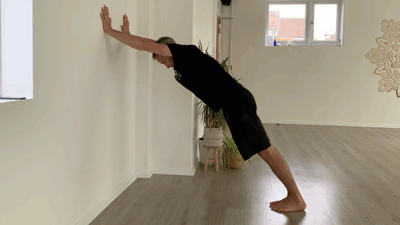
2. Wall Lean Calf Raises
Gymnasts do calf raises by the hundred, they know how important it is to have strong calves. This is a calf raise with a difference because you are leaning forwards against a wall, it stretches the calf and ankle much more, plus it creates more mobility through your toes which is super important for strong healthy feet.
Lean forward with your hands on a wall so your body is at about a 45-degree angle. Engage your glutes and core, then lift your heels up over your toes as much as possible whilst pushing into the wall. Then lower your heels back down as far as you can to stretch your calves and ankles. If you can easily touch your heels on the floor, step your feet a little further back from the wall and repeat. Again 25 reps are the goal here.
After the wall lean calf raises repeat another set of 25 reps of the Tibialis Raises above. Watch this video to see how to do Wall Lean Calf Raises
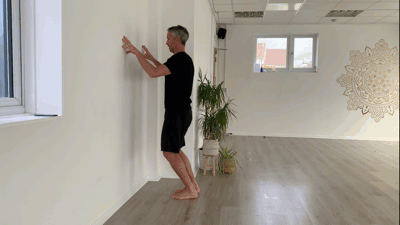
3. Soleus Raises
The soleus is at the back of your lower leg, underneath and below your calf muscle. Getting it strong and long is really important for good ankle mobility and to help protect your knees.
Stand arm’s length from the wall with your hands resting on the wall at shoulder height. Then lift your heels up and bend your knees so your knees and hips move towards the wall and your knees are in front of your toes. There should be a vertical alignment from your head, to shoulders to hips and knees. From this starting position, lift your heels up and down to perform the bent knee calf/soleus raise. Your head should lift up and down slightly with the reps. Perform 25 reps. Watch this video to see how to do Soleus Raises
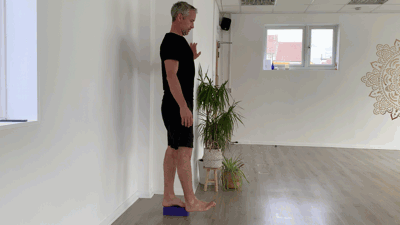
4. Reverse Step Ups
Now that we have built strength and mobility in the lower legs, it is time to move up above the knees and strengthen our quads, just above the knees in a muscle called the Vastus Medialis Oblique (VMO – one of the 4 quadriceps muscles). The full version of the reverse step up is essentially stepping up onto a step backward. But to begin with we want to start with both feet on flat ground and build up.
Stand with your feet together and use a wall or back of a chair for support. Stand on one leg and bend the knee forwards, stretching out your other leg to touch the floor with your heel as far forwards as possible without your standing foot heel coming off the floor. At the same time lean back with your head and shoulders. Straighten the standing leg to return to the start position.
Once you can do this with zero pain in your knees for 12 reps per leg, increase the height of your standing foot by standing on a thick book or a yoga block. This means you have to bend further into the standing leg knee to get your other heel to touch the floor in front of you and reverse step up to get back onto the raised surface. Build up to the height of a staircase step then add weights to increase the intensity. Watch this video to see how to do Reverse Step Ups
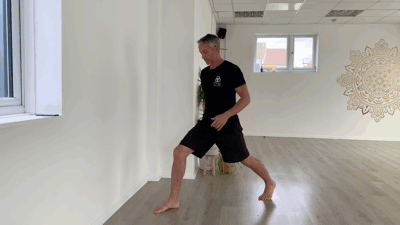
5. Split Squats
The split squat is a great exercise to improve mobility, balance, and strength in both legs, plus, as it is a single-sided exercise it shows up imbalances in strength, mobility, and balance between the left and right legs really quickly, so then we can work to improve the weaker leg to bring about more balance.
It’s best to learn this exercise with something to balance on, so set up alongside a wall, window sill, or the back of a chair or two. Split your stance, one foot forward and one foot back, keeping them hip-width apart. Bend your front knee and try to keep your back leg as straight as possible. Encourage the front knee to move forwards over the top of your front foot as you lower down into the split squat. You can gently allow your front heel to lift off the floor to get lower into the split squat. Work in a pain-free range and use the balance aids to push down onto with your arm(s) if you feel stuck at the bottom of the movement. Keep your spine upright during the movement. The goal is 5 bodyweight reps per leg without balance aids, then add small weight increases to progress. Watch this video to see how to do Split Squats
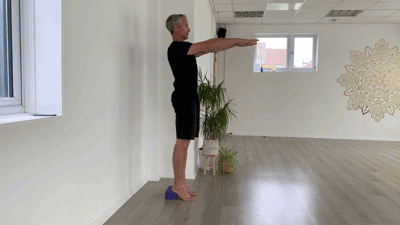
6. VMO / Cyclists Squats
VMO Squats (also known as Cyclist Squats) are a simple and awesome way to build strength through a full range of movement for your legs. By using a book, wedge, or small block to put your heels on, we free up any potential restriction of movement in the ankles that can limit how low some people can squat. As a result, it is easier to perform a full depth squat with the knees fully flexed so your quads get stronger in the end range of movement. Start off just bodyweight with this exercise until you can comfortably perform 20 reps in a set, then you can increase the intensity by holding weights.
Set your heels up on your book, wedge, or small block so they are hip-width apart and your feet are angled downwards. Make sure you feel stable before you start squatting, if not, put a chair on either side of you so you can hold onto the back of each chair with your hands to guide and assist you up and down through the squats. Keep your chest as upright as possible, then drive your hips downwards over the back of your ankles into a deep squat. Your knees should track forwards over your feet at hip-width as you squat up and down doing your reps. Watch this video to see how to do VMO Cyclist Squats
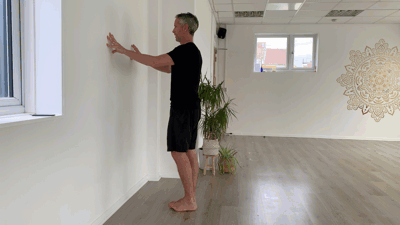
7. Standing Hamstring Curls
The final exercise in our protects your knees series focuses on building strength in your hamstrings on the back of your upper leg. This is the last piece of the puzzle in terms of the major muscles above and below the knee that we want to get strong to help protect the knee.
Unless you specifically train your hamstrings to contract or you sprint regularly, chances are they are going to be short and weak and susceptible to injuries such as hamstring strains or tears if you suddenly put large loads through them (like the parents’ race at school sports day!). The standing hamstring curl is a great entry-level hamstring exercise.
Place your hands on a wall or the back of a chair for support. From a tall standing position, pick up one foot and curl the foot up behind you as close to your hips as possible, hold it there for 5 seconds, then lower it slowly back to the floor. Perform 5 reps on one leg then repeat on the other leg. Watch this video to see how to do Hamstring Curls
Looking for even more inspiration? Check out this variation from the Sworkit app.
Sworkit’s Rehabilitation and Mobility Training Workout Collection
Workout in style with Sworkit’s Rehabilitation and Care Collection We offer a wide range of exercises to keep you happy and motivated. Getting fit doesn’t have to be complicated. You don’t need fancy workout equipment. Just bring yourself, some dumbbells, and a healthy dose of motivation!
It is important to practice self-care in many ways. Exercise is crucial for your physical health and overall wellbeing.
Do this workout routine two to three times throughout the week and consider trying some of Sworkit’s other knee-friendly exercises to reduce knee pain. Enjoy a healthy life, and start exercising today!

Comment section